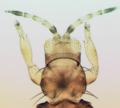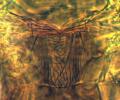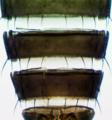Frankliniella intonsa
Recognition data
Distinguishing features
Both sexes fully winged. Body and legs variable, mainly brown with head and pronotum often paler than abdomen, tibiae and tarsi largely yellow; major setae dark; antennal segments III–IV yellow with apices shaded; fore wing pale with setae dark. Head wider than long; three pairs of ocellar setae present, pair III slightly longer than side of ocellar triangle, arising on anterior margin of triangle; postocular setae pair I present, pair IV short, no longer than diameter of hind ocellus. Antennae 8-segmented; segments III–IV with sensorium forked, segment VIII as long as VII. Pronotum with 5 pairs of major setae; anteromarginal setae shorter than anteroangulars, one pair of minor setae present medially between posteromarginal submedian setae. Metanotum with 2 pairs of setae at anterior margin, campaniform sensilla absent. Fore wing with 2 complete rows of veinal setae. Abdominal tergites V–VIII with paired ctenidia, on VIII anterolateral to spiracle; posteromarginal comb on VIII complete, with short slender microtrichia arising from triangular bases. Sternites III–VII without discal setae.
Male smaller and paler than female; tergite VIII with no posteromarginal comb; tergite IX with posterolateral setae stout in larger males; sternites III–VII with transverse pore plate.
Variation
This species varies considerably in size and color, but is not known to produce such distinctive color morphs as are found in Californian populations of F. occidentalis. Teneral females are much paler than mature females, with the apical abdominal segments dark.
Related and similar species
This species is not known from California, but is included here as a potential invader. Currently 230 species are listed in the genus Frankliniella, with up to 130 further names placed into synonymy (Nakahara, 1997). This high rate of synonymy has been due to unrecognized variability in size and color of so many species. This variability is indicated in the more common species such as F. intonsa by the large number of subspecific synonyms listed. This species is very similar to F. occidentalis, but has the postocular setae considerably shorter, and apparently never has campaniform sensilla on the metanotum.
Taxonomic data
Current valid name
Frankliniella intonsa (Trybom)
Original name and synonyms
- Thrips intonsa Trybom, 1895: 182
- Physopus vulgatissima albicornis Uzel, 1895: 96
- Physopus vulgatissima fulvicornis Uzel, 1895: 96
- Physopus vulgatissima nigropilosa Uzel, 1895: 96
- Physapus brevistylis Karny, 1908: 278
- Frankliniella breviceps Bagnall, 1911: 2
- Frankliniella vicina Karny, 1922: 94
- Frankliniella intonsa maritima Priesner, 1925: 165
- Frankliniella formosae Moulton, 1928: 324
- Frankliniella formosae tricolor Moulton, 1928: 325
- Frankliniella intonsa rufula Keler, 1936: 104
- Frankliniella intonsa norashensis Jakhontov & Jurbanov, 1957: 1279
Family placement
Thripidae, Thripinae
Common names
European flower thrips
Biological data
Life history
Breeding on leaves and in flowers.
Host plants
Recorded from a very wide range of unrelated plant species with little evidence of specificity.
Tospoviruses vectored
TSWV, TCSV, GRSV
Crop damage
Recorded as a pest of fruit trees in southern Europe, and of vegetable crops in Taiwan.
Distribution data
Area of origin
Possibly western Asia
Distribution
Not known in California, but recorded from Washington and British Columbia; widespread across the Old World, from western Europe to Vietnam, Japan and Taiwan.






